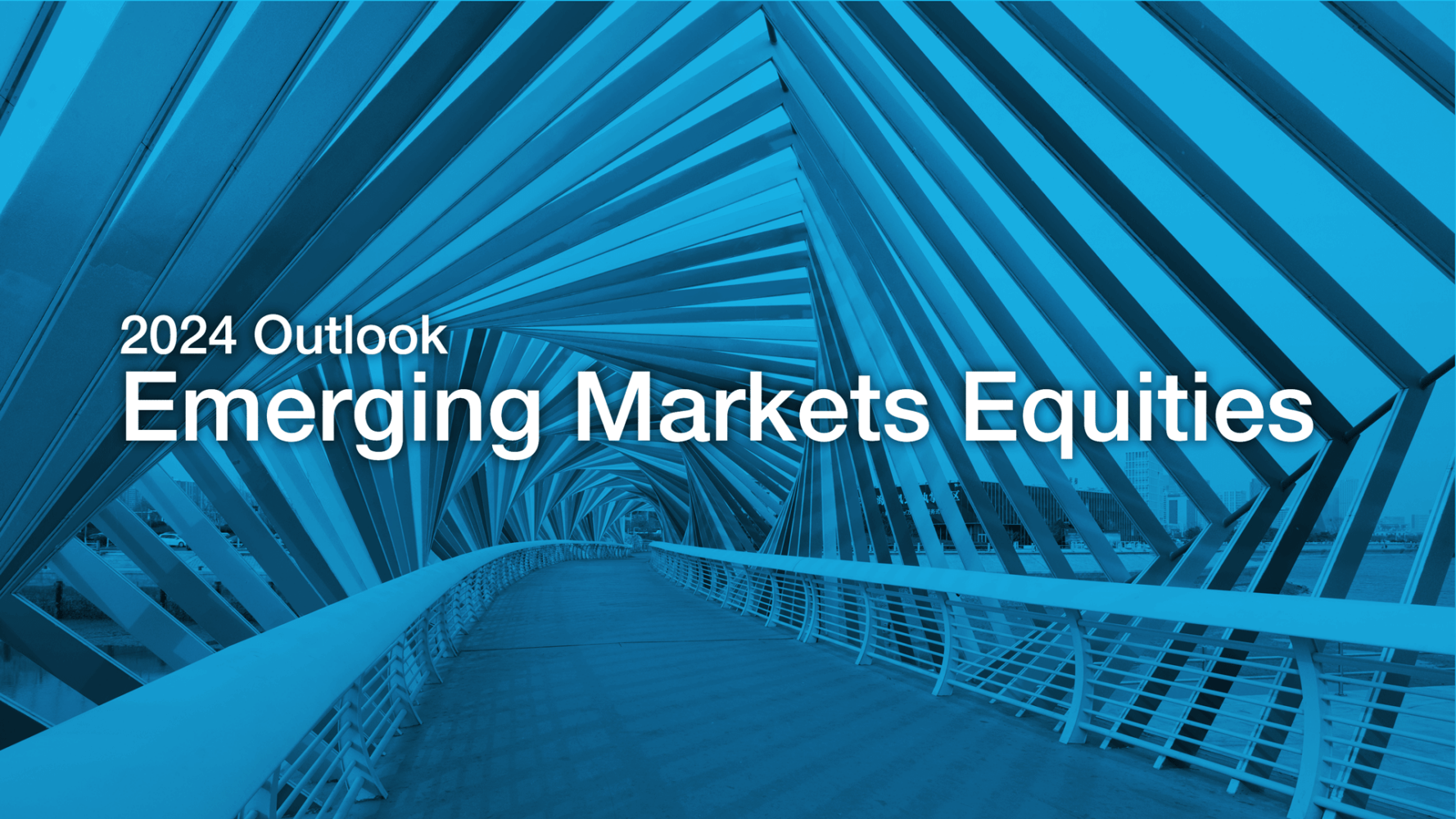
From continuing supply chain realignment to the emergent consumer and more, these factors align for underappreciated and mispriced emerging markets in 2024.
Contrary to recent experience, over the last 25 years, emerging market equity returns have generally outpaced their developed market peers. Since the end of 1998, the S&P 500 has delivered a 7.55% annualized total return, just behind emerging markets at 7.83%. While the NASDAQ has delivered 10.06% annualized return over the entire period, almost half of the total return has come since the COVID pandemic hit. What may come as a surprise is that both the SPX and NASDAQ had significantly lagged EM in cumulative (and annualized) performance before COVID despite the pedestrian returns delivered by Emerging Markets over the last decade. It is worth noting that this was the case despite the period of generally easy money in the U.S. for most of the previous 15 years and the supercharged period of deeply negative real rates since the pandemic. Despite the historically compelling performance, investors remain underweight emerging markets today and have continued to lighten their position in 2023. We think it’s time to take a fresh look at your emerging markets allocation.
Emerging Markets’ Performance Has Been Compelling
Annual Returns (1999-2023)
Source: Bloomberg
The performance data quoted represents past performance; it does not guarantee future results.
But 2023 was better for many emerging markets than headlines may suggest. For the year, EM delivered a respectable 10.12% total return, ahead of the long-term returns of the NASDAQ, the S&P 500, and EM itself. EM returns fell short of the S&P 500 and developed markets for the year, excluding the U.S., which delivered a 26.26% and 16.22% total return, respectively. But as is most often the case with EM, it’s hard to paint the broad and diverse set of markets with a single brush stroke. Several markets within EM significantly outpaced the broad U.S., and ex-U.S. developed market indices, especially if you adjust for the narrow leadership within the U.S. markets by looking at the S&P Equal-Weight Index, which is only up 13.84% for the year.
A cross-section of smaller markets like Poland, Hungary, and Greece and larger markets like Mexico, Brazil, India, South Korea, and Taiwan led emerging markets last year. Half of the 24 markets of EM, representing almost 60% of the index’s weight, delivered higher returns than the S&P Equal Weight Index.
The critical headwind for the broader index remained China. After rising sharply at the end of 2022 with the end of zero COVID policy, the Chinese markets reversed course at the start of 2023. They drifted lower over the year due to concerns about the property market and the strength of the broader recovery. If you exclude China from EM, the index would have been up 20% for the year, in line with developed market peers.
A Few Select Markets, Especially China, Accounted For Much of EM’s Lagging Performance in 2023 (Percent Change)
Source: Bloomberg
The performance data quoted represents past performance; it does not guarantee future results.
2023 Was Better than Headlines Suggest – What Drove the Strength?
While no single factor contributed to the high performance of specific markets within EM, various factors helped propel the strongest-performing markets.
Disciplined Monetary Policy: Many central banks pursued aggressive monetary policy to tame inflation and stabilize their currencies relative to the dollar. While the increase in interest rates in the U.S. has created pain in some parts of the U.S. economy, this type of rate environment is a more frequent occurrence in EM and, therefore, more manageable for the banking system and consumers of credit. Most EM markets, except those with idiosyncratic issues like Turkey, have seen inflation return to normal.
Emerging Markets Central Banks Are Not behind the Curve on Inflation
Source: Bloomberg, FactSet, and Thornburg (as of November 29, 2023)
Solid Economic Growth: As EM continues to shake off the COVID hangover, most markets have entered a period where economic growth has been substantial or, in some cases, expected to accelerate as interest rates fall. This period of relative strength is coming when developed market growth has slowed and is expected to slow further in 2024 as high interest rates take their toll on the broader economy. A widening EM growth differential has historically catalyzed EM relative outperformance as equity investors seek better opportunities in other markets.
The Fed Pivot: The mere hint of potential near-term pivot of U.S. monetary policy has been enough to push many markets across EM to year to date and, in some cases, near all-time highs. The last time we had a pivot of this sort was early in 2016 when Janet Yellen decided to step back from a more hawkish stance. Over the next two years, emerging markets delivered a 94% total return. Looking back at the last few peaks in U.S. interest rates, it typically signals EM outperformance in the following 12 to 24 months.
Emerging Markets Have Historically Outperformed 12 Months after the Last Fed Rate Hike
Source: Global X ETFs with information derived from Bloomberg data as of March 31, 2022
Emerging Markets: MSCI Emerging Markets Index; Developed Markets: S&P 500 Index
The performance data quoted represents past performance; it does not guarantee future results.
The AI arms race: A large part of the technology supply chain resides in North Asia – Taiwan, South Korea, and parts of China. This region produces everything from leading-edge chips to handsets. With every significant company in the world rushing to roll out an AI strategy during 2023, there was considerable unexpected strength of demand for some aspects of technology hardware. This greatly benefited South Korean and Taiwanese suppliers as the broader hardware and memory cycles were bottoming. We believe that the AI technology ramp is still in its infancy. Many end users are still trying to understand the “right” use case for them, which will lead to uneven demand but generally be a favorable tailwind for these sectors and markets.
The Long-Term Case for Emerging Markets Remains Intact
Emerging markets represent almost 60% of global GDP and the bulk of incremental GDP growth but just over 10% of global market capitalization. Over the next decade, the emerging market middle class is set to double and represent more than 50% of the global middle class by 2030. The growth in the middle class is happening across all major emerging markets. It comes when interest rates are declining for cyclical and structural reasons, another tailwind to consumption growth. Looking back at the U.S. as an analog, the period between 1980 and the present was one where middle-class growth was robust, and interest rates were generally on a downward trajectory. During that period, the S&P 500 rose from 100 to over 4700 today. We think many emerging markets will benefit from similar dynamics over the next decade.
Market Capitalization Does Not Reflect the Structural Decline in Rates
Source: Bloomberg
Is this time different?
In short, we think several factors are converging to potentially drive EM outperformance after a long period of subpar returns. These factors include:
- Low valuations and light positioning signal low expectations
- Stable/accelerating GDP growth while DM slows
- The prospect of U.S. rate cuts
- Stable dollar
- Stretched U.S. valuations after 15 years of low interest rates
While none alone are a catalyst, they collectively provide a fertile backdrop for EM green shoots.
EM Discount to Developed Markets and the Fed Funds Target Rate
Source: Bloomberg
Things to Watch
What If Developed Markets Slow? Many Emerging Markets Will Be Just Fine.
Most forecasters expected a recession in developed markets during 2023. This expectation has shifted to 2024 when many forecasters expect a slowdown or modest contraction in the coming year. In many respects, the idea that if developed markets sneeze, emerging markets catch a cold has become outdated. Global trade and fixed asset investment are no longer the primary driver for EM growth as the EM consumer has stepped into the forefront. We would categorize the impact of a DM slowdown across EM in three different ways.
POSITIVE: More consumer-driven markets will likely benefit from a developed market slowdown. India is the clearest example of a beneficiary of any slowdown in global growth due to its limited exports and a consumer segment sensitive to inflation. The shift China has made toward consumption is surprising to most, as investment has slowed, and exports are no longer a strong tailwind. More than half of Chinese GDP and even more GDP growth comes from consumption today. Both countries will continue to benefit from solid middle-class growth this year and in subsequent years.
NEGATIVE: Markets that rely on exports and global trade to drive their growth will likely face headwinds if key end markets soften. Mexico, for example, will likely slow if the U.S. economy stalls this year due to its close economic ties to the U.S. Other markets facing headwinds due to their export orientation include South Korea and Taiwan. This might be partially offset by a recovery in many technology hardware end markets, which are tied to both markets.
NEUTRAL: Latin American and Middle Eastern economies that benefit from abundant natural resources should see more stable growth driven by ongoing capital spending in commodity production. Most of these markets also benefit from a growing middle class which is shifting the growth driver towards consumption. In addition, several of these markets have suffered from high interest rates and should receive a boost as rates fall during 2024.
China’s Erratic Recovery Will Likely Continue to Be, Well, Erratic
China remains the elephant in the room. Beijing’s influence in the space ranges from its softening economy to the reaction of global corporations and governments to its policies and reach. We attribute China’s weakness last year to several factors.
Foremost, the damage to the economy from harsh COVID restrictions was likely worse than anyone expected. Consumers remain very cautious and, as a result, remain slow to get back out and spend. The government, especially local governments, has also been slow to introduce fiscal stimulus programs. Both may be tied back to China’s deflating property bubble. Real estate is the primary savings vehicle for Chinese consumers, and property sales make up a significant source of revenue for local government. With property market values uncertain at best, consumers and government stimulus appear frozen. Chinese savings rates remain elevated so consumers can spend. We think it will take longer for China’s property market situation to resolve itself so that consumer spending may remain cautious.
Looking ahead to 2024, despite all the challenges discussed above and the subsequent disappointing performance, China remains one of the fastest-growing economies in the world. Even with an overall population poised to decline, the middle class is still increasing and remains an essential driver of the economy. We are seeing attractively valued opportunities across a variety of sectors.
The Long-Term Reshoring Trend Will Continue in 2024, Benefiting Emerging Markets
Last year saw the theme of reshoring away from China to other emerging countries gain much attention among investors. Reshoring is not a new trend. Due to rising wages, supply chains have been moving away from China for nearly a decade. Geopolitical tensions and recent COVID-related policy blunders accelerated the exodus of foreign investment. Foreign direct investment in China turned negative in late 2023, and, as seen in the chart below, net exports have declined for nearly 20 years.
Chinese Exports Have Been in Decline for Nearly 20 Years
Source: World Bank
However, the “winners” of this trend have not and likely will not be developed nations. Instead, supply chain investment is shifting elsewhere, such as in Thailand, Malaysia, India, Mexico, and Indonesia.
But China will remain a powerhouse in the global supply chain, even as firms shift low-end manufacturing to regions closer to their end markets, such as Mexico and Eastern Europe. This is what we refer to as a “China Plus One” shift. That is, firms are looking to China plus a nation closer to their markets for supply chain relief. Moreover, China is becoming a much more sophisticated manufacturer as Beijing develops world champions, adding research and development intensity in various advanced industries ranging from electric vehicles to industrial robotics and automation. This is the next leg of Chinese development as the nation shifts to high-tech exports.
Outlook
China
We expect overall growth to slow but remain relatively robust. Consumers may remain cautious in light of property market challenges.
India
We expect growth to remain strong and perhaps accelerate as inflation moderates. Valuations remain elevated but supported by the medium-term growth outlook and continued strong domestic market inflows.
North Asia
Cyclical and structural factors will lead to recovery across most major technology end-markets. We expect strength in these end-markets to offset headwinds related to slowing DM growth.
Latin America
Falling real rates and faster real wage growth should help domestic growth and consumption across the region. We expect commodity price stability and an uptick in FDI across the region to remain a tailwind. Valuations are highly attractive and do not reflect the solid fundamentals and increasing tailwinds.
MENA
We are hopeful that the Israel-Hamas war will be peacefully resolved soon and that it will not spill over into a broader regional dispute. If so, this leaves room for the ongoing reform process across the region (in particular UAE and Saudi Arabia) to further unlock productivity gains and drive growth. Despite strong fundamentals, valuations remain attractive due to softening oil prices and the outlook for falling U.S. rates (the region often underperforms in a stable/falling USD backdrop).
Positioning
China
We focus on opportunities that are less sensitive to external factors. This can be challenging to find in the current environment and has led us to reduce our exposure to China.
India
We continue to balance valuation and long-term opportunity. We are finding good opportunities across financials, real estate, healthcare, and consumer.
North Asia
We are finding good opportunities to invest in the cyclical recovery and structural growth aspects of the technology supply chain.
Latin America
Despite firm and improving fundamentals, we are finding extremely attractive valuations across the region. We expect currencies to remain supported due to conservative monetary policy and consistent FDI. We have invested in opportunities across financials, real estate, healthcare, consumer, and commodities opportunities.
MENA
Despite short-term headwinds, we think the medium-term fundamentals remain solid and underappreciated by the broader market. We are invested in the region’s financials, industrials, and real estate sectors.
Discover more about:
More Insights

Investment Perspectives from the Road: The UAE

Investor Update: A Potential Reprieve for the Municipal Bond Tax Exemption

Thornburg Investment Income Builder Fund – 2nd Quarter Update 2025

FOMC Update: Fiscal Challenges Taking a Back Seat to Geopolitical Risks

Thornburg Expands European Presence with Active Fund Placement


